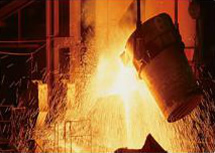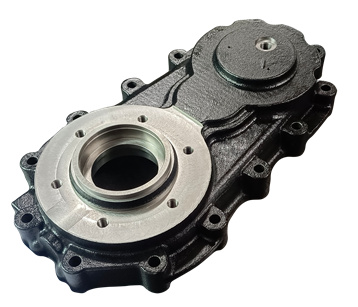Sand casting, also known as sand molded casting, is a metal casting process characterized by using sand as the mold material.
Creating a mold is the first step in the sand casting process. Each casting needs a mold. A sand mold is formed by putting the sand into each half of the mold. The sand is stacked around the pattern, which is a replica of the shape of the casting. When the pattern is removed, the cavity forming the casting remains. Any internal features of castings that cannot be formed by the pattern are formed by separate cores made of sand before forming the mold. The mold-making time includes positioning the pattern, packing the sand, and removing the pattern. The mold-making time is affected by the size of the part, the number of cores, and the type of sand mold. Lubricant is typically applied to the surface of the mold cavity to facilitate removal of the casting. The use of lubricants also improves the flow of the metal and can improve the surface finish of the castings. The lubricant used is selected based on the temperature of the sand and the molten metal.
After the mold is made, it must be prepared to pour the molten metal. First, the surface of the cavity is lubricated in order to remove the castings after casting. Then, the core is positioned and the mold halves are closed and securely clamped together. It is necessary to keep the mold half sealed to prevent any loss of material. The molten metal is kept at the set temperature in the furnace. After the mold is clamped, the molten metal can be cast from the holding vessel in the furnace and poured into the mold. Pouring can be done manually or by automated machines. Sufficient molten metal must be poured to fill the entire cavity and all channels in the mold. Filling time is very short, to prevent the early curing of any part of the metal.
Once poured into the mold, molten metal begins to cool and solidify. When the entire cavity is filled and the molten metal solidifies, the final shape of the casting is formed. Until the end of cooling time, the mold can be opened. The cooling time required can be estimated from the wall thickness of the casting and the temperature of the metal. Most of the possible defects are the result of the solidification process. If some molten metal cools too quickly, the part may shrink, crack or incompletely. Precautions can be taken when designing parts and molds.
After a predetermined set time, the sand mold can simply be broken and the castings removed. This step, sometimes referred to as getting rid of sand, is usually shaken by a vibrating machine and burned out of the bottle. Once removed, the castings may have some sand and oxide adhering to the surface. Blasting is sometimes used to remove residual sand, especially from the inside surface, and to reduce the surface roughness.
During cooling, the material from the mold channels solidifies on the part. These extra material must be manually trimmed by cutting or sawing or using a trimming machine. The time it takes to trim excess material can be estimated from the size of the casting. Larger castings require longer dressing times. Waste from this trimming is discarded or reused during sand casting. However, it may be necessary to remediate appropriate chemicals for scrap before it is used in conjunction with non-recycled metals.
• Almost any ferrous and non-ferrous metals can be casted by sand casting
• Parts caan vary greatly in size, weight and shape. Weight can be from ounces to hundreds of tons
• Small quantity or large quantity
• Relative low cost for high volume parts
ISO 9001
Ningbo PR.
Ningbo City
Phenolic sand molding casting process
Founded 2012
Factory area 20,000SM
Annual Capacity 8,000 tons
High chromium cast iron, carbon & alloy steel, wear resistant steel
Max size - 1500 X 1500 X 1500 MM
Weight range -5 - 2500KG
Tolerance - CT10 - 12
Surface roughness - Ra25




ISO 9001 IATF 16949
Ningbo JM.
Ningbo City
Clay sand molding , shell mold casting
Founded 1993
Factory 20,000SM
200 employees
Annual capacity30,000tons
Nodular cast iron, grey iron
Max size - 610 MM Linear x 510 MM Did
Weight range -0.2 - 100KG
Tolerance - CT8 - 12
Surface roughness - Ra 12.5 - 25





ISO 9001
Ningbo LX.
Ningbo City
Clay sand molding , shell mold casting
Founded 1970
Factory 18,000SM
100 employees
Annual capacity 6,500tons
Nodular cast iron, grey iron
Max size - 600MM Linear x 600 MM Did
Weight range -0.2 - 100KG
Tolerance - CT7 - 10
Surface roughness - Ra 12.5 - 25








IATF 16949
Anhui HL.
Anhui Province
Static Pressure Green Sand Casting, Vacuum Casting, Resin Sand Casting, Lost Foam Casting, DISA Vertical Mold Casting
Founded 1958
Factory area 580,000SM
1300 employees
Annual Capacity 500,000 tons
Nodular Cast Iron, ADI, Grey Iron
Max size - 1100 X 600 MM Linear X 800 MM Dia.
Weight range -1 - 10000KG
Tolerance - CT8 - 12
Surface roughness - Ra25 um


KW Molding Line

Pouring Robot

Vacuum Molding Line

Resin Sand Casting Line

Automatic Closer

Lost Foam Casting Line

Automatic Online Pouring Machine

DISA Vertical Molding Line














